Hoi An: 3 Days in Vietnam’s City of Lanterns
After spending five days in southern Vietnam, in Ho Chi Minh City and the Mekong Delta, I hopped a flight to central Vietnam in order to visit the popular city of Hoi An. Known for its old town splashed with bright yellows and lit up at night by lanterns, this town is a popular tourist spot. It came highly recommended on just about every Vietnam itinerary out there, and upon arriving, I quickly found out why. Read on to discover why I loved my time in Hoi An.
The Basics
Getting There
Hoi An can be reached by bus, train, and plane. But, because I’m not a fan of the idea of spending nearly 20 hours on a bus or train, and because my time in Vietnam is short, I opted to fly. Fortunately, flights throughout Vietnam are super cheap on Vietnam’s budget airline, VietJet. My flight from Saigon to Da Nang, the city with the airport closest to Hoi An, was about $45. Because VietJet is a budget airline, you are only allowed to carry on a max of seven kilograms. I did manage to pack for this trip in a backpack, but it weighs about eleven kilos with my laptop and such. So, I paid an extra six dollars online before getting to the airport to avoid a higher fee there for checking in my bag.
When I arrived in Da Nang, I took a shuttle that I booked through my hostel that cost 150,000 dong ($6.50). The trip from Da Nang to Hoi An is about 45 minutes.
Accommodations
In Hoi An, I stayed at the Imperfect Hostel, which, contrary to its name, is really great and near perfect. I was very happy that they no bunk beds whatsoever, so there was no opportunity for me to get stuck with a top bunk, and breakfast was included in the morning. Moreover, all of the staff members were so, so kind. They always asked me about my day, and each night they offered a free drink. The best part was that my two night stay there cost less than $10!
Currency
The Vietnamese currency is the Dong, and right now the exchange rate is roughly 23,000 Dong to 1 U.S. dollar. There were plenty of ATMs in Hoi An to pull money out of when I needed to.
Highlights of Hoi An
Tailoring
Hoi An, Vietnam is known as the world capital of tailors. The city is home to more than 200 tailoring shops, so it is a huge temptation to get something (or several somethings) made while in town. I easily succumbed to the temptation, and after doing some research on the best tailors in town, I set out to get some clothes custom made. Here is an honest account of my experiences with tailors in Hoi An:
BeBe Tailors
BeBe is the most recommended tailor in the city – its TripAdvisor page is full of gushing 5 star reviews about patrons’ individualized experience getting gorgeous clothing made. It is known as a high-end tailor specializing in suits and gowns – this, coupled with its popularity, makes their prices a bit more than other tailors in the city. They currently have three locations, all within the old town of Hoi An.
Because this shop came so highly recommended by countless reviews and blogs, I decided to go there to get a pair of dress pants made. I went to their second location, and when I walked in, I observed the walls of fabrics and the many workers sitting at tables of their phones. One woman finally acknowledged me when I walked up to her and told her what I wanted. She had me sit down and dumped a bunch of fabric samples in front of me.
Then, another sales associate told me that she would be the one helping me out, and she helped me pick out a simple, black fabric after seeing a photo of what I wanted. I had read stories of associates pulling out rolls of fabric for customers to be dead certain that was what they wanted, but my girl seemed to be rushing me along. She hurriedly took my measurements and curtly informed me that the pants would cost me $60. I definitely should have bargained here, but I was not at my most assertive, so I simply agreed and was told to come back the next day for a preliminary fitting.
The next day at one in the afternoon, I returned for my first fitting, and was actually pretty happy with what they came up with. The fabric could have been a bit thicker and stiffer, but they looked really nice even without additional tailoring. The woman I had worked with the day before studied the pants and made some marks on the pants, giving me suggestions on how they could be made to fit even better. And, just 3 hours later, they did fit even better. They fit perfectly. After just a day and two fittings, I walked away with a custom-fit pair of black dress pants.
I overpaid and I was less than impressed with the customer service here that so many people had raved about, but in the end, I left with a pair of dress pants that I hope I will wear for several years.
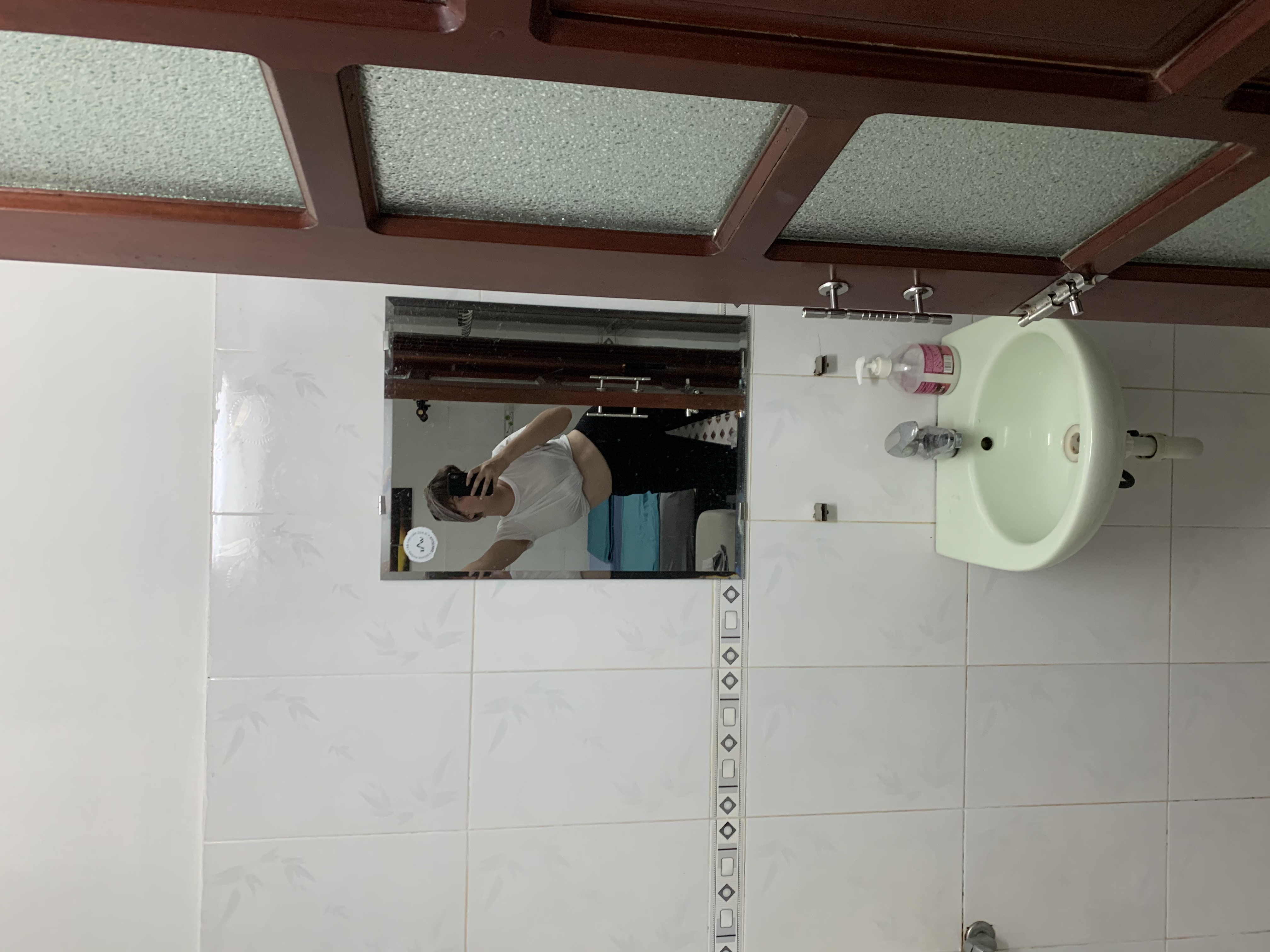
Here is a horrible photo of me in my hostel bathroom wearing my new dress pants. It’s the only photo I have wearing them so far haha.
The Hoi An Cloth Market – Tata Cloth Shop
After trying out a high-end tailor, I wanted to give a shot to a tailor in the cloth market, where I could pay significantly less. I decided on a very simple dress design and went in the market, letting prospective tailors know that my max budget for the dress was 450,000 dong ($20). After stopping at a few stalls, I eventually settled on TaTa Cloth Shop (stall 5A) because the girl there was so sweet and attentive. She went back and forth with me, trying to convince me to pick more expensive fabrics and get more than one thing made, but in the end she respected my budget and helped me pick a simple cotton fabric in a dusty orange color.
Like with BeBe, the dress was done the very next day for a fitting. When I first put it on, the sleeves squeezed the tops of my arms a ton, but that issue was easily remedied in only two hours. By my second fitting, it fit great. The dress is loose, basic, and long enough to wear in temples throughout Asia. The quality of the fabric is definitely lower than some of the high end tailors, but I was happy with the process and the price I was able to get here.
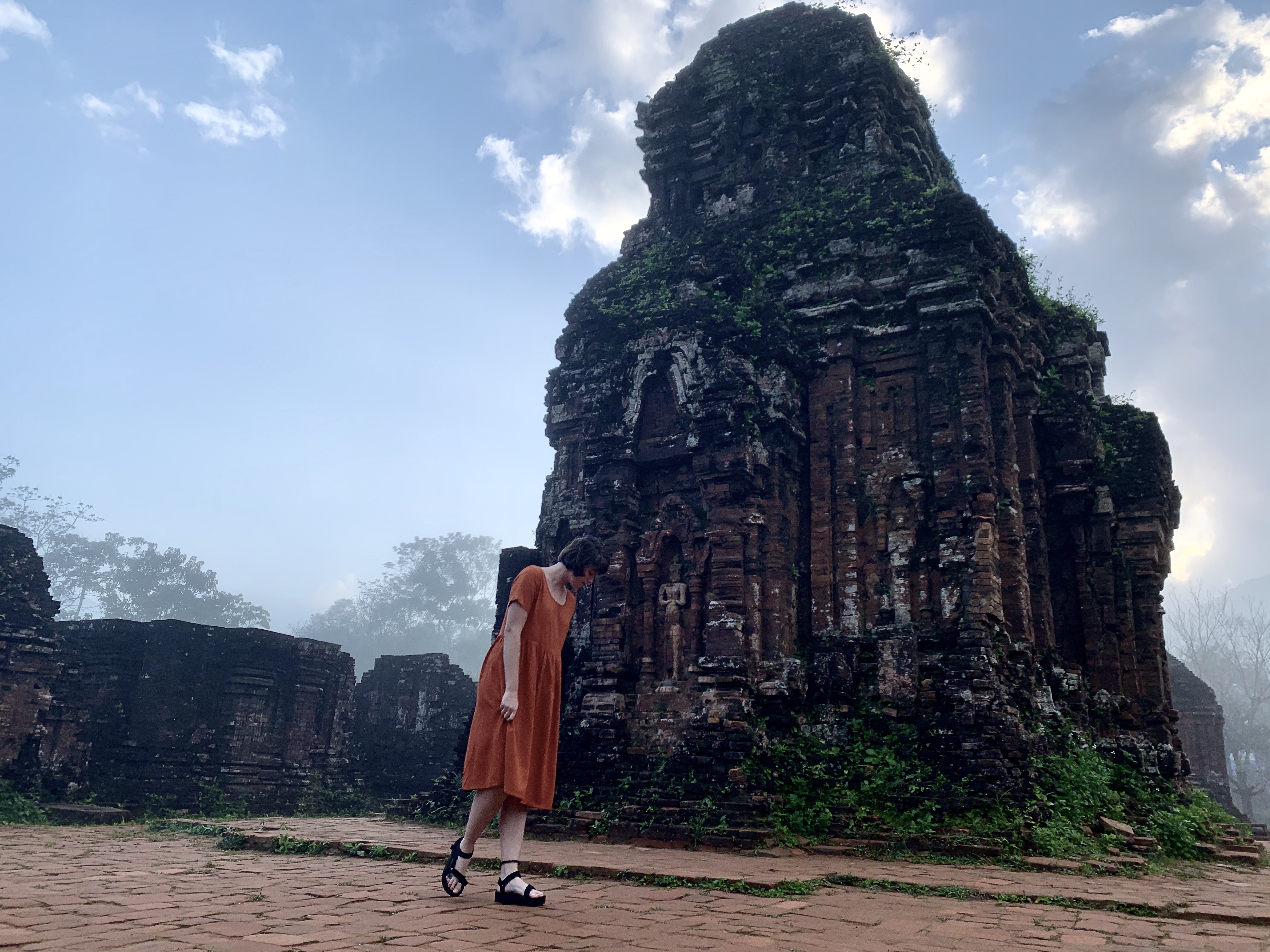
A look at the dress I had made – loose, simple, and made in orange cotton
Mien Linen Tailor
I stumbled upon Mien’s gorgeous linen tailoring simply by complimenting her outfit when she checked me into my hostel, where she works while also creating beautiful pieces of linen clothing. Mien was the sweetest, and I knew as soon as she told me that she made her outfit that I was gonna have to have a piece made by her.
I browsed through her samples and quickly decided on a short sleeve linen top with buttons down the back and two little pockets on the front, done in a light gray linen fabric. It was what she was wearing that day, and I wanted basically the exact same shirt, just in a much bigger size to fit my significantly taller frame. She took several measurements, and all of them paid off because the top fit absolutely perfectly the first time I tried it on.
The shirt set me back 480,000 dong ($20.75), and it was worth every penny. It felt much more meaningful to support a small business owner that obviously took so much pride in each and every piece she made. If I could design and sew half as well as her, I’d also wear my creations each and every day. My only regret is not getting more stuff made. I can’t recommend Mien’s work more – so if you find yourself in Hoi An, make your way across the river from the old town to the Imperfect Hostel for some linen pieces!
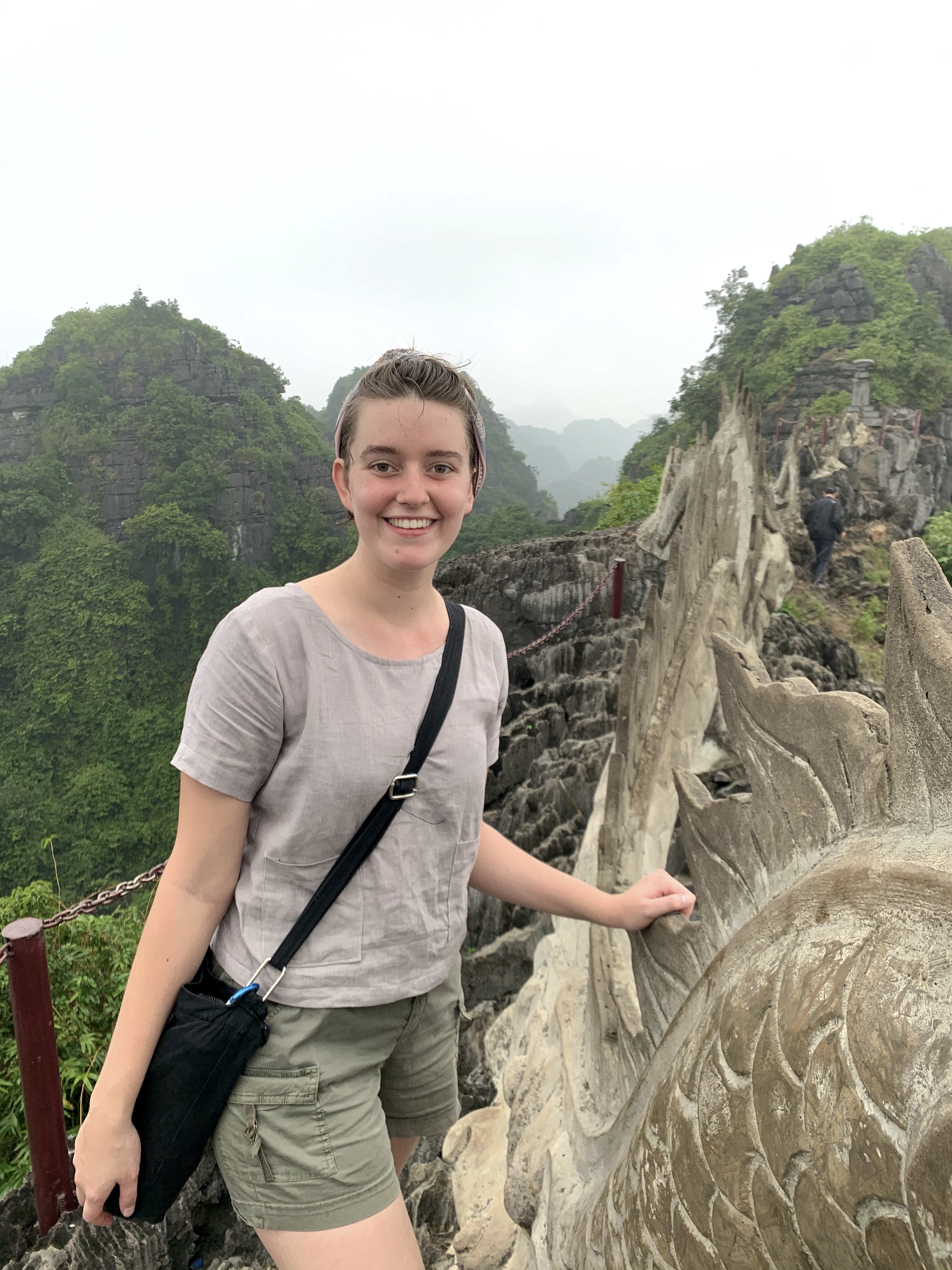
My linen top made by Mien at the Imperfect Hostel in Hoi An
Wandering Around the Old Town
The astoundingly picturesque old town of Hoi An is perfect to wander around day and night, as it is mostly devoid of the millions of motorbikes that seem ever-present in Vietnam. It is also filled with cute alleys, tons of shops and restaurants, lots of aforementioned tailors, and a huge market. I spent most of my days criss crossing the streets of the old town, stopping in stores to browse, admiring the intricacies of the many pagodas and temples, and drinking quite a lot of smoothies. The best time to wander the old town was early in the morning before the tour groups added to the crush of tourists.
At the various entrances of the old town, visitors can buy tickets to enter the various sites around the area. It is 120,000 ($5.15) for five tickets that get you entrance into anything that has a ticket booth out front, which ranges from pagodas to shows. I used my tickets to go into pagodas and watch a traditional music and dance show.
At night, the city shines with the lights of hundreds of lanterns strung up between shops and along the dozens of boats that traverse the water. Visitors can pay for a 30 minute boat ride and light a little paper lantern to let out on the water. I skipped the boat ride here to save money for a boat ride in Ninh Binh, one of my next stops, and I also refrained from lighting a lantern as I was unsure of the environmental impact. The town does look amazing at night, though, and is well worth a walk around.
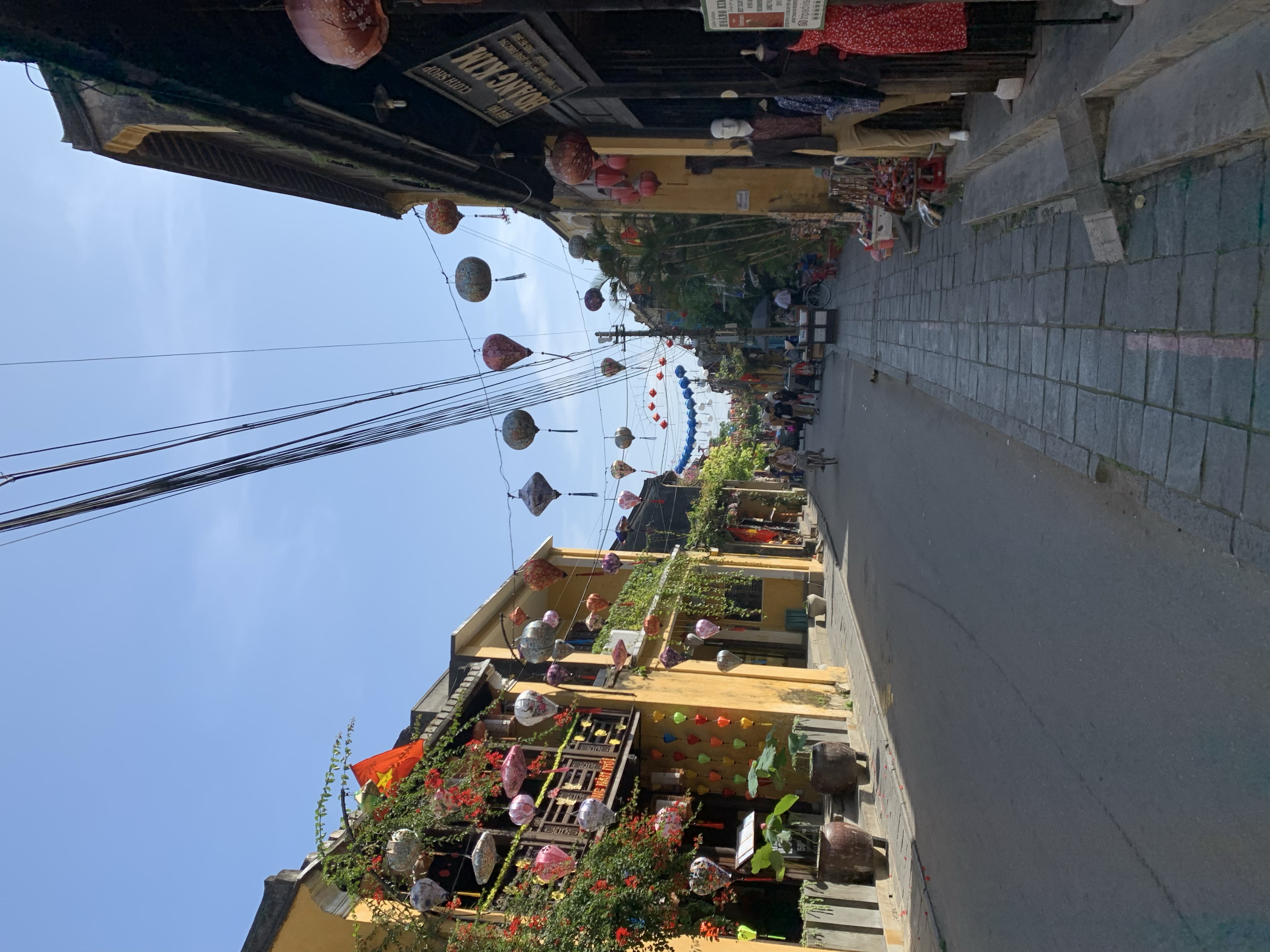
One of the walking streets of the old town
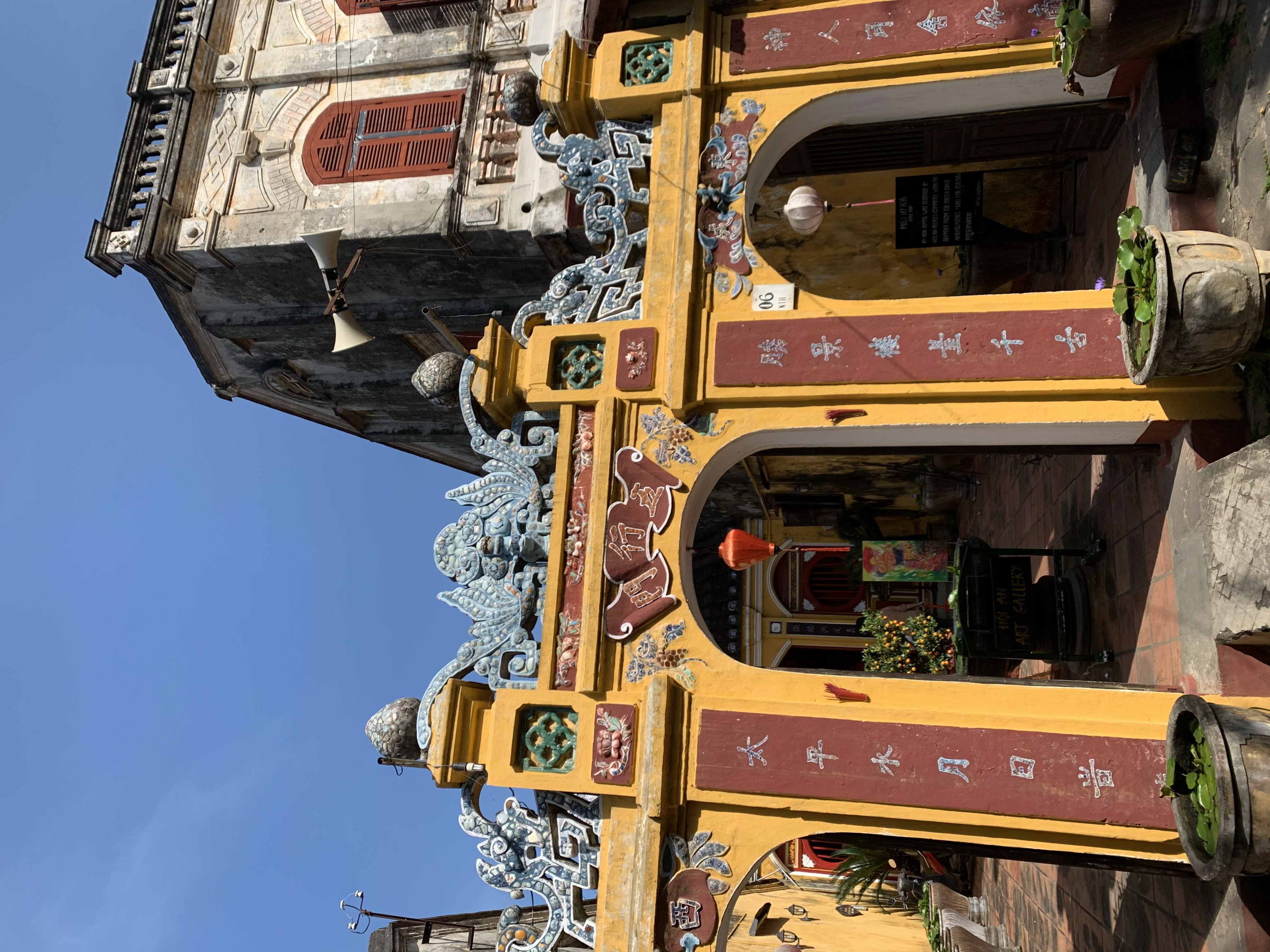
A temple entrance in the old town

A beautiful, old house I came across down an alley in the old town

An alley complete with bright colors and fruit trees in the old town

The iconic ‘Dragon Bridge’ of the old town of Hoi An

Incense in one of the pagodas in the old town




The colorful boats that dot the river going through the old town


Hoi An at sunset

One of the many beautiful lantern shops of Hoi An
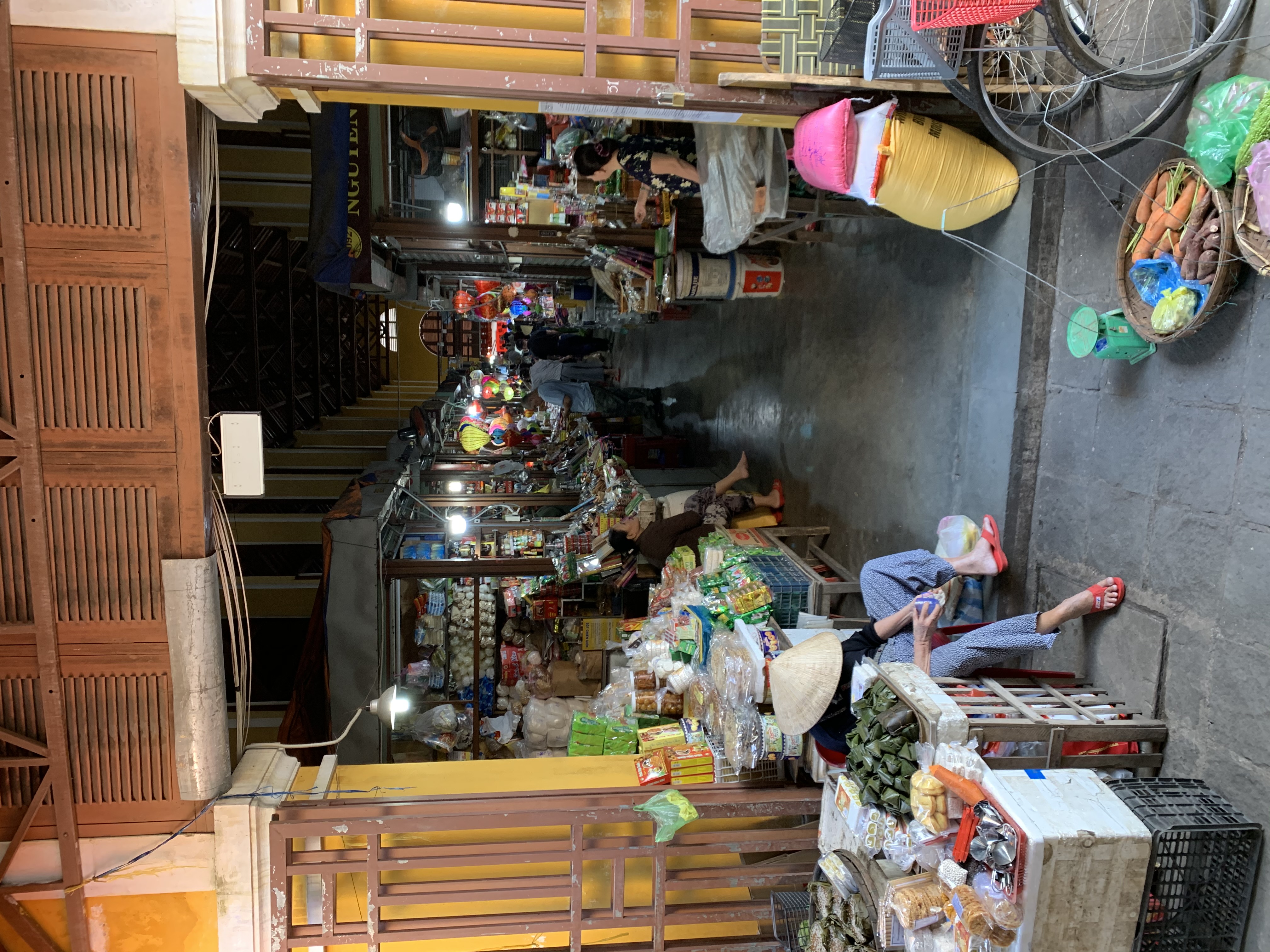
Hoi An’s market
Eating Delicious Food
Banh Mi
It was in Hoi An that I tried my very first Banh Mi, and it was at a place said to have the best Banh Mi in all of Vietnam. The restaurant, visited by the incredible Anthony Bourdain, is called Phuong, and they pump out Banh Mi to a huge line all day long. The combination of me being a creature of habit, liking the Banh Mi so much, and it only costing 30,000 dong ($1.30) caused me to go there for lunch all three days that I was in Hoi An. Yummm.
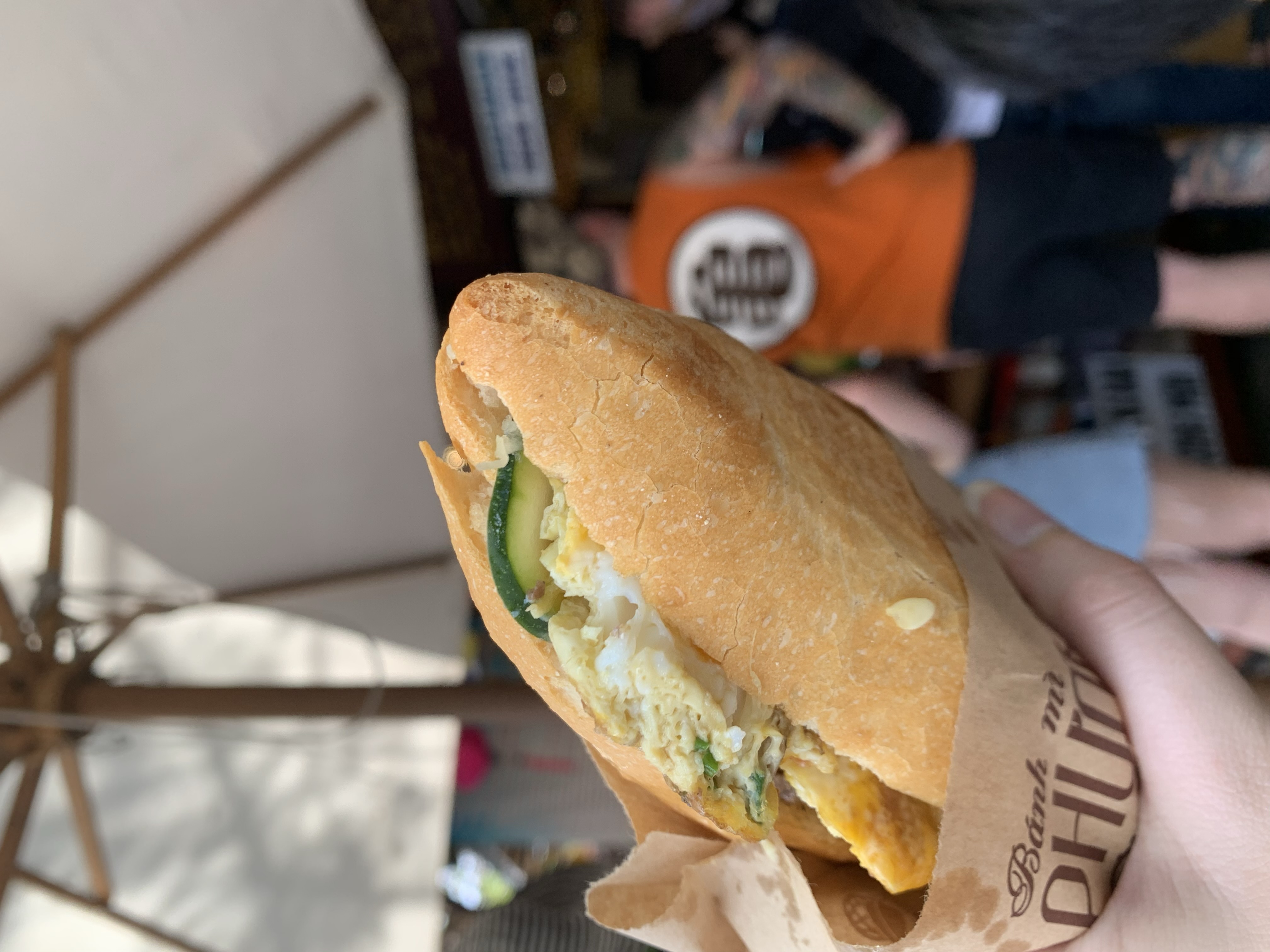
Banh Mi from Phuong in Hoi An
Cao Lau
Cao Lau is a traditional noodle dish special to Hoi An – the rice noodles are soaked in a specific lye water from the town that is said to make the noodles distinct from noodles anywhere else in the world. The dish is also served with greens, pork, and crunchy little crackers. I had this dish two nights in a row, but at different restaurants that happened to be on the same street – Cau Lau Khong Gian Xanh and Quan An Ty Ty. It was equally delicious at both restaurants, and cost 40,000 dong ($1.70) for a bowl at Khong and 30,000 dong ($1.30) for a boul at Quan An Ty Ty.
- Cao Lau from Khong Gian Xanh
- Cao Lau from Quan An Ty Ty
White Rose Dumplings
White Rose dumplings are another dish specific to Hoi An – so specific that they are only produced at one restaurant that delivers the goodies to other restaurants around the city. These dumplings are made from rice paper filled with shrimp, and then topped with more shrimp and some crispy shallots. They are served with a sauce made from shrimp broth, hot chilies, lemon, and sugar. What makes them extra special is that they are steamed in water drawn from the Ba Le well, which is filtered and purified 15-20 times before use.
With that level of dedication to producing a dumpling, I knew I had to go to the source: Tran Tuan Ngai, or the White Rose Restaurant. It is a few minutes outside of the old town, and well worth the walk and the steep price (by Vietnam standards) of 70,000 dong ($3) to try a plate of the White Rose dumplings and watch the women making them by the hundreds in the back.
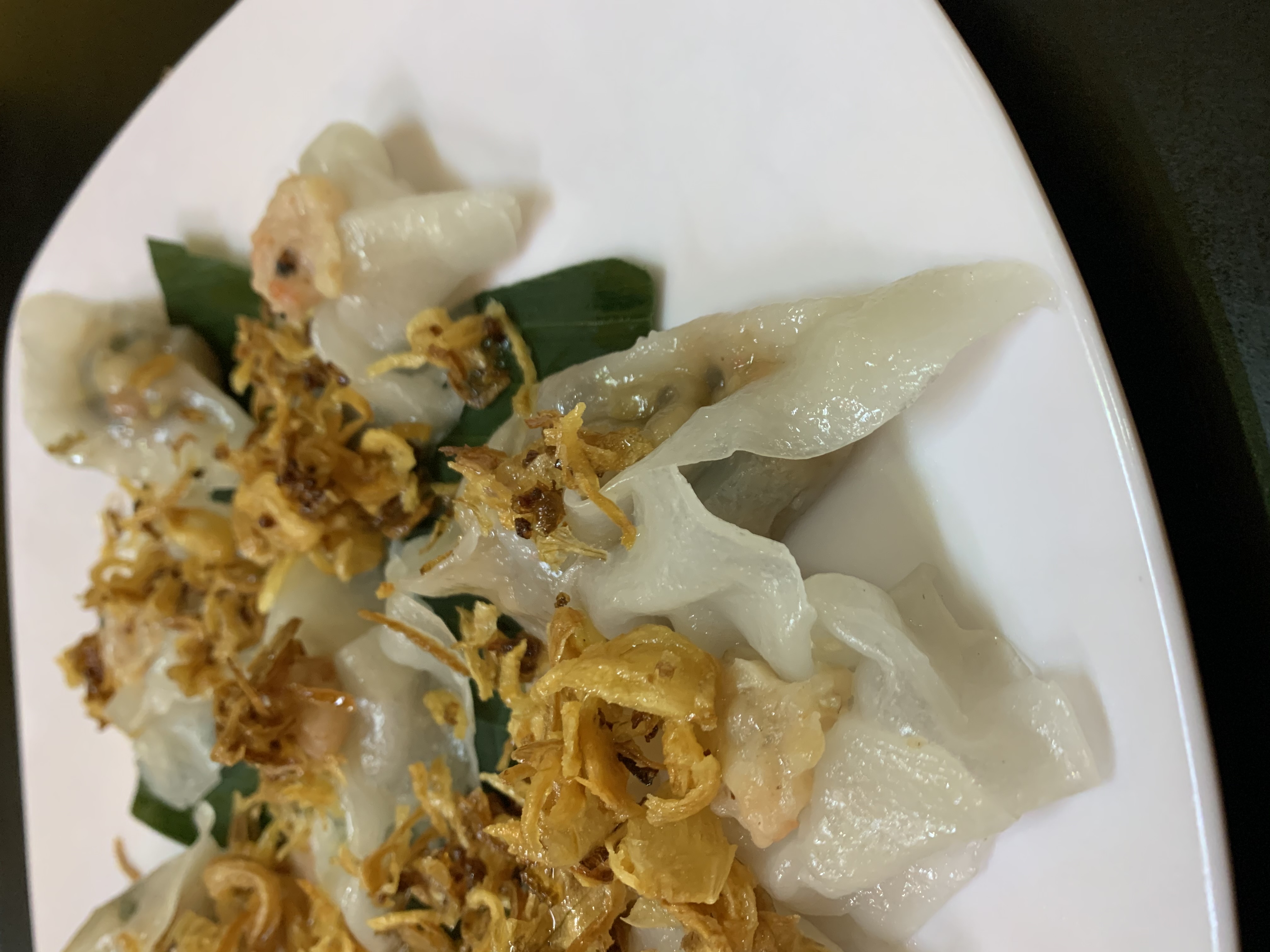
White Rose dumplings from the White Rose restaurant in Hoi An
Biking to Neighboring Villages
On my second day in Hoi An, I decided to escape the crowds of the old town and bike around the surrounding areas. My hostel had bikes for rent for the day for 50,000 dong ($2.15), but just around the corner from my hostel I found a guy renting decent bikes for the day for 25,000 dong ($0.85). So, less than a dollar to rent a bike with a lock until 8pm – not too shabby.
When I got my bike, I set off for the Tra Que vegetable village, which was about a 20 minute ride from the old town. There, I aimlessly biked around stretches of ride fields, observing the farmers in their traditional hats and the water buffalo roaming the fields. The ride was nice and peaceful.
Then, after a tailoring fitting, I set back out on the bike to the Cam Thanh coconut village, which was also about a 20/25 ride from the old town. Like in the vegetable village, I simply biked around, enjoying the sights along the way. Biking was a pleasant and easy way to explore what lies beyond the tourist hub of Hoi An’s old town.
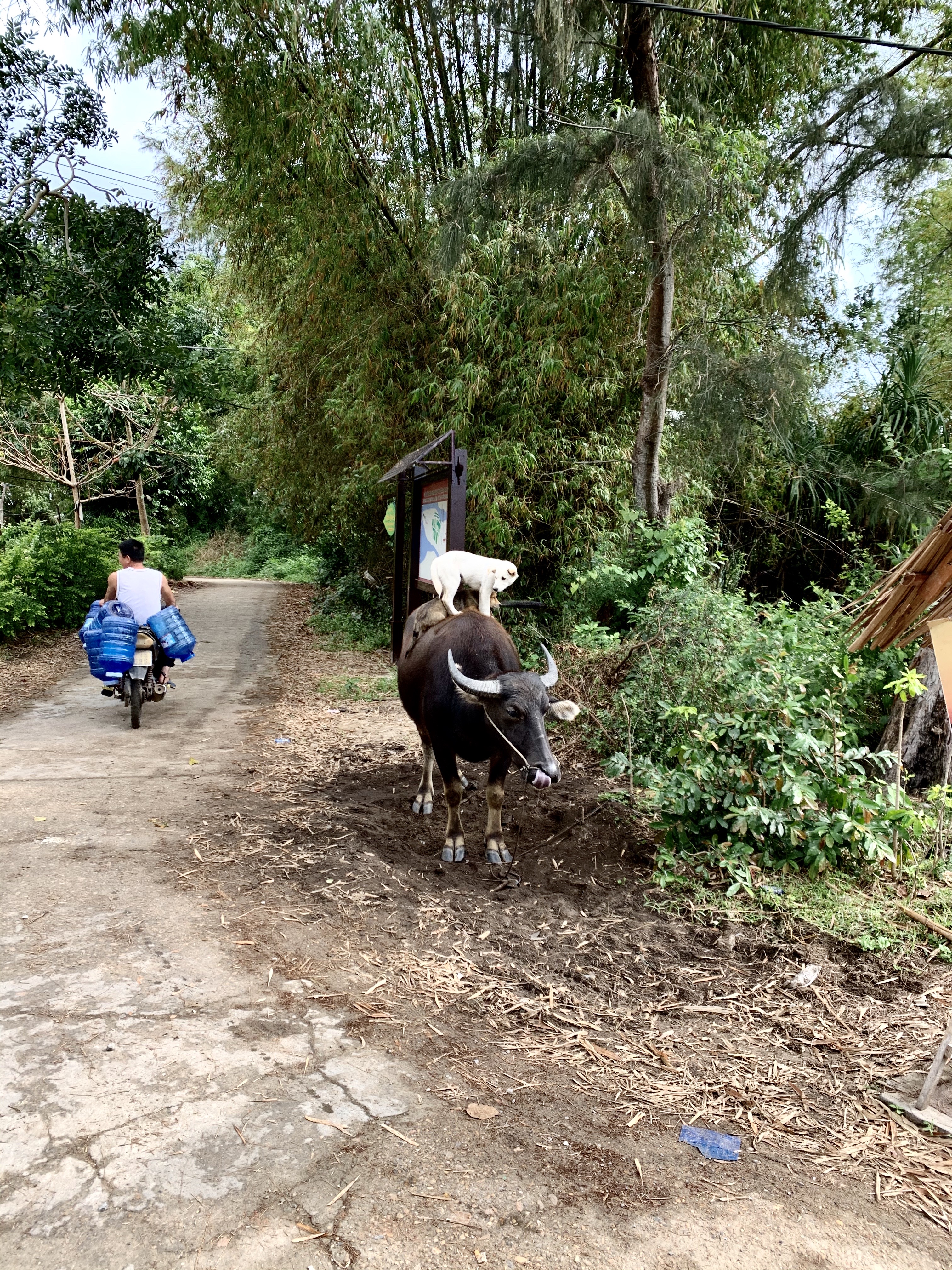
A water buffalo with two dogs on its back seen in the Tra Que vegetable village
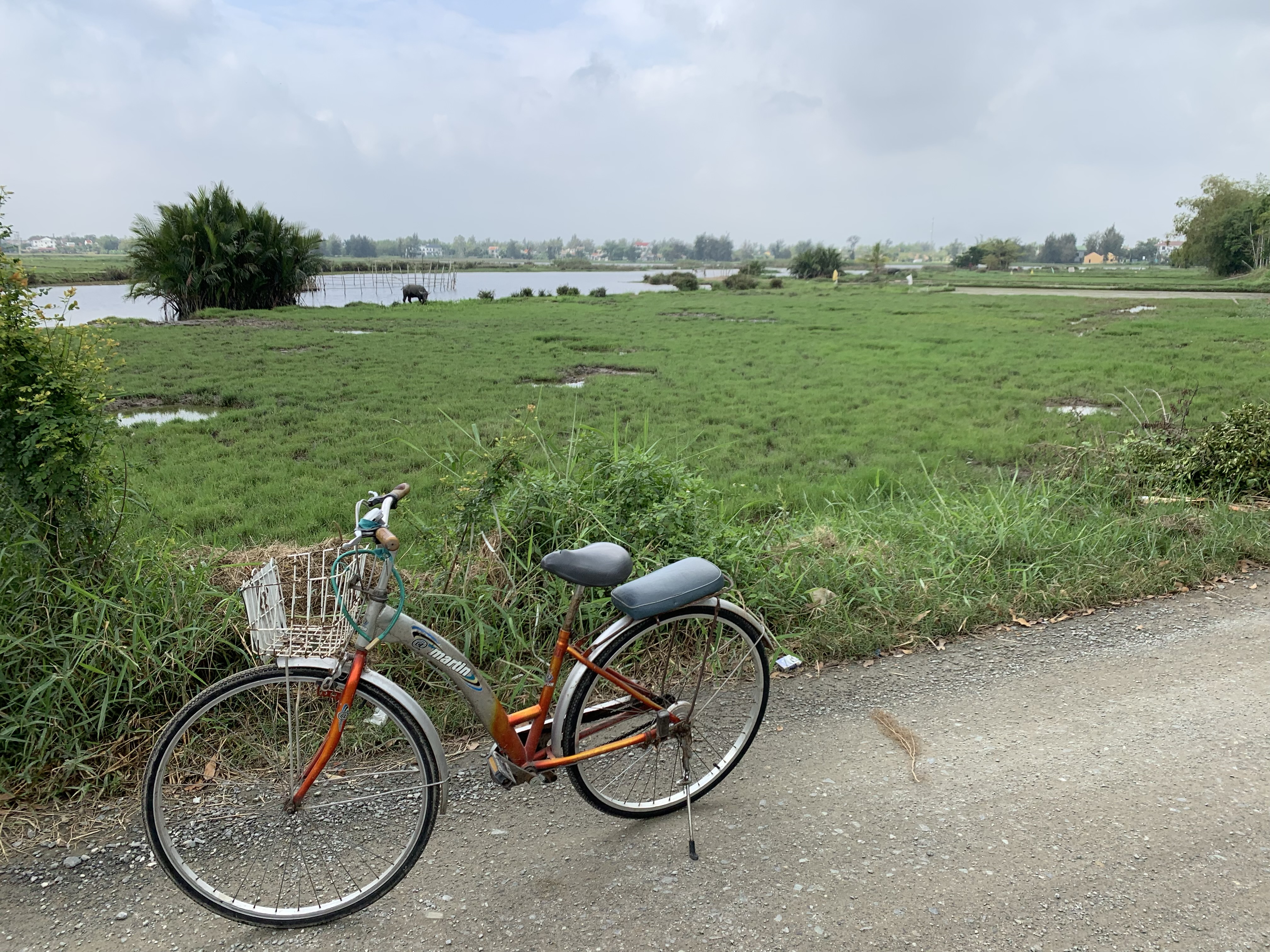
My bike in the fields of the Tra Que vegetable village
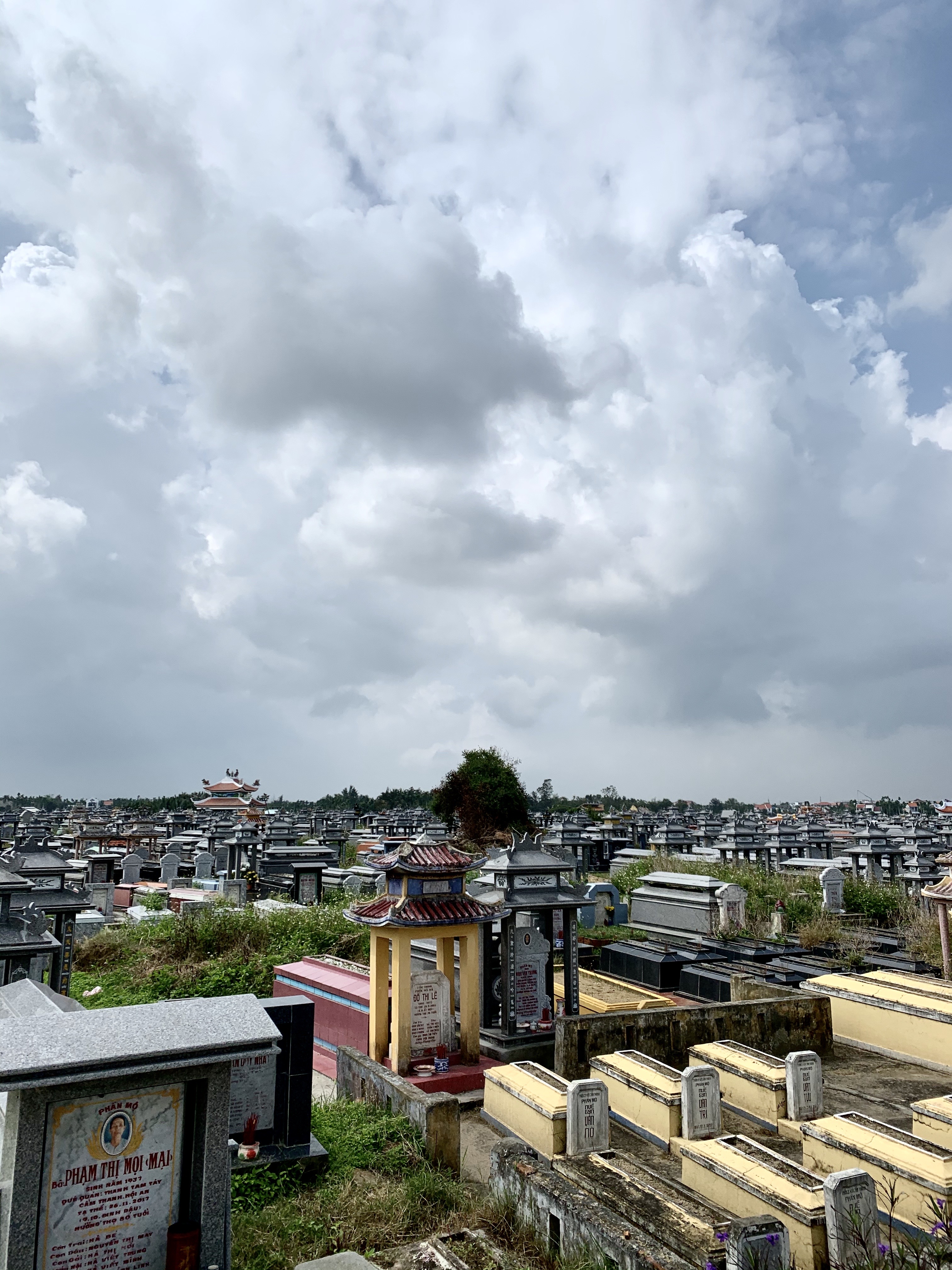
A cemetery in the Cam Thanh coconut village
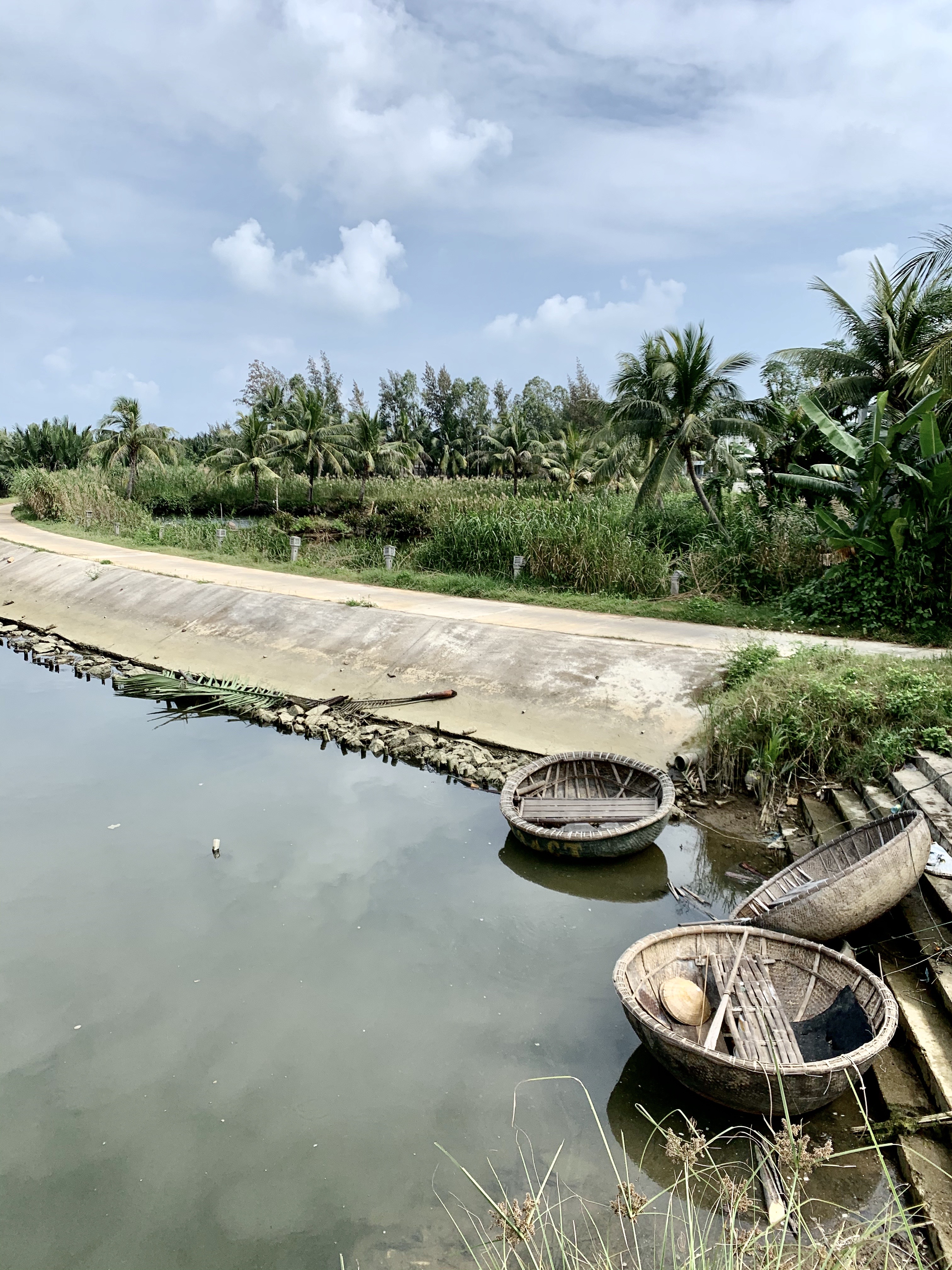
The round bamboo boats used in the Cam Thanh coconut village
My Son Sanctuary
This isn’t technically in Hoi An – it’s about 40 kilometers away, but it is a popular half-day trip from the city. In prior research about Hoi An, most bloggers recommend visiting the My Son Sanctuary, an ancient temple complex, during a sunrise tour right after the complex opens. My hostel offered the tour for 500,000 dong ($21.50), but I decided to shop around for a better price. I ended up finding transportation and a guide for 250,000 dong ($10.75) through Anh Khoa Hoi An, and then I simply had to pay 150,000 dong ($6.45) for the entrance fee when we arrived for a grand total of 400,000 dong ($17.20). Not a ton of savings, but hey, 100,000 dong can easily get me three banh mis or three bowls of pho.
The bus picked me up at my hostel at 5:30 in the morning, and then we had an hour or so drive out to My Son. When we arrived, we were the only group there, and we had the complex to ourselves for quite a bit. Our guide did a great job of explaining the history of the site and the current efforts to restore more temples as they find them. They are now partnering with the Indian government to restore a major cluster of temples.
The site is beautiful and serene and, unfortunately, greatly marred by U.S. bombings. My Son is littered with huge bomb craters, and many of the temples sustained a great deal of damage from the bombs because the Viet Cong used the My Son complex as a base during the war. It is disappointing when war leads to the destruction of history and culture on top of the destruction of lives. The My Son Sanctuary is very interesting, and is well worth a visit if you have a few days in Hoi An.
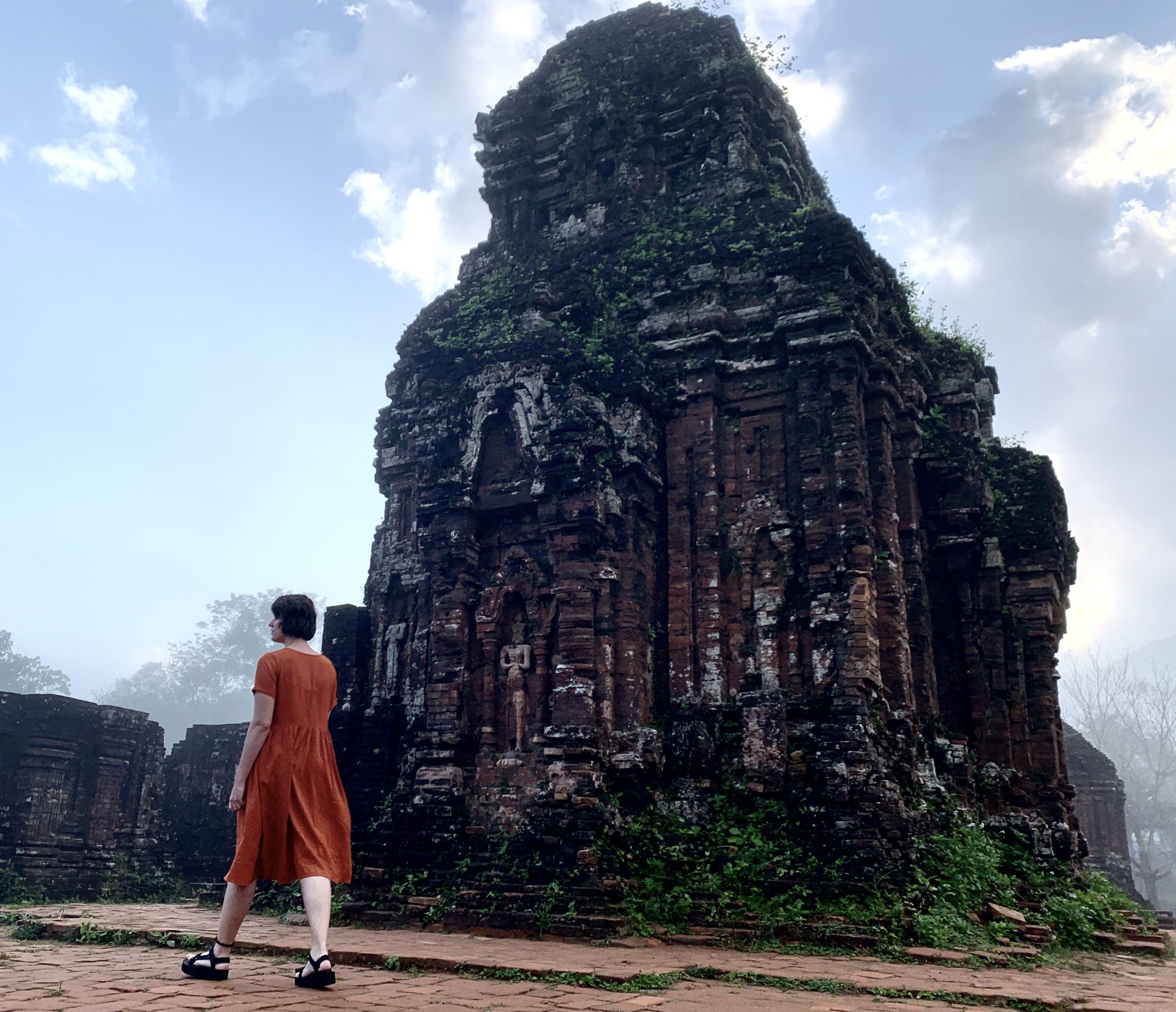
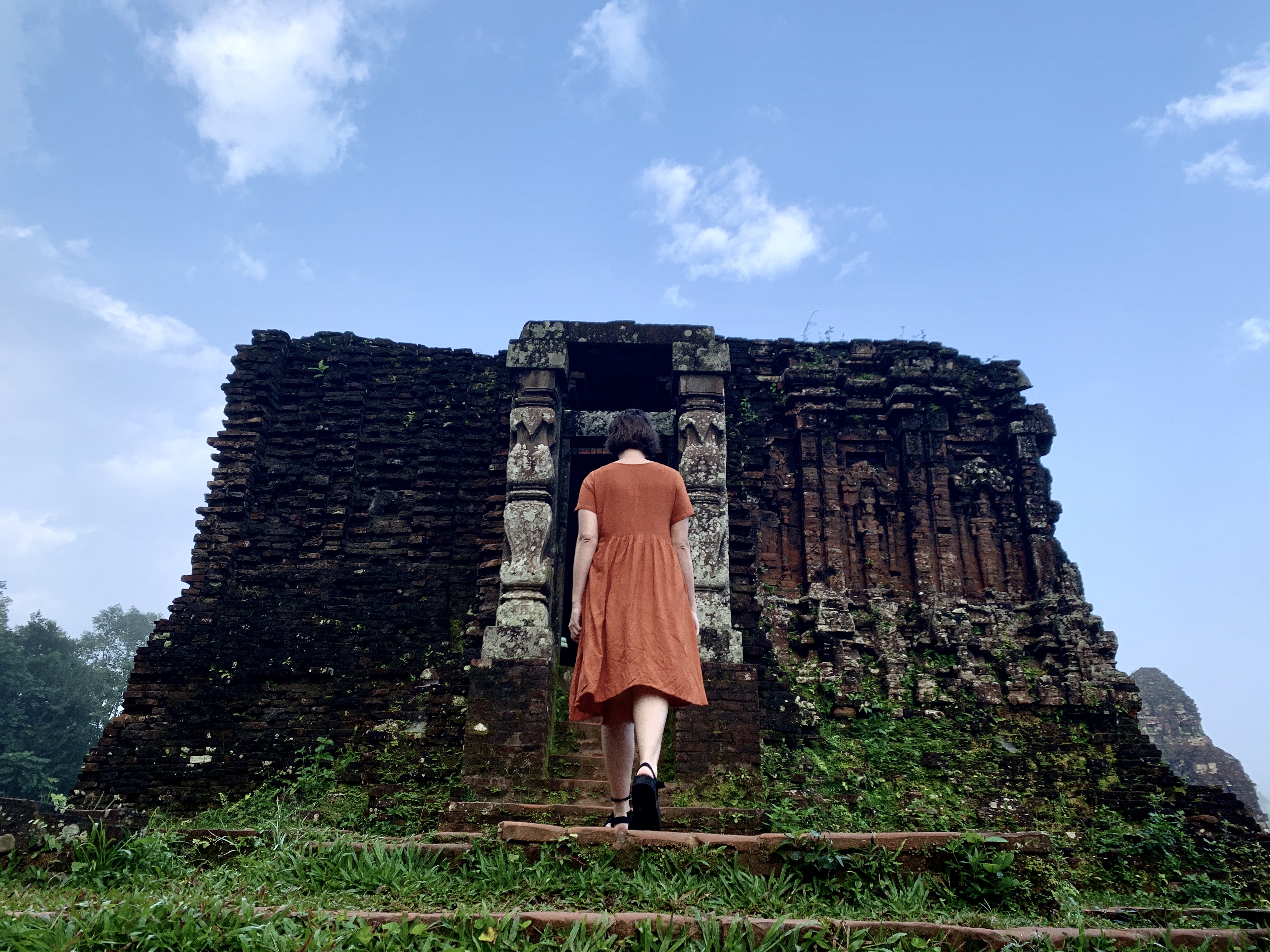
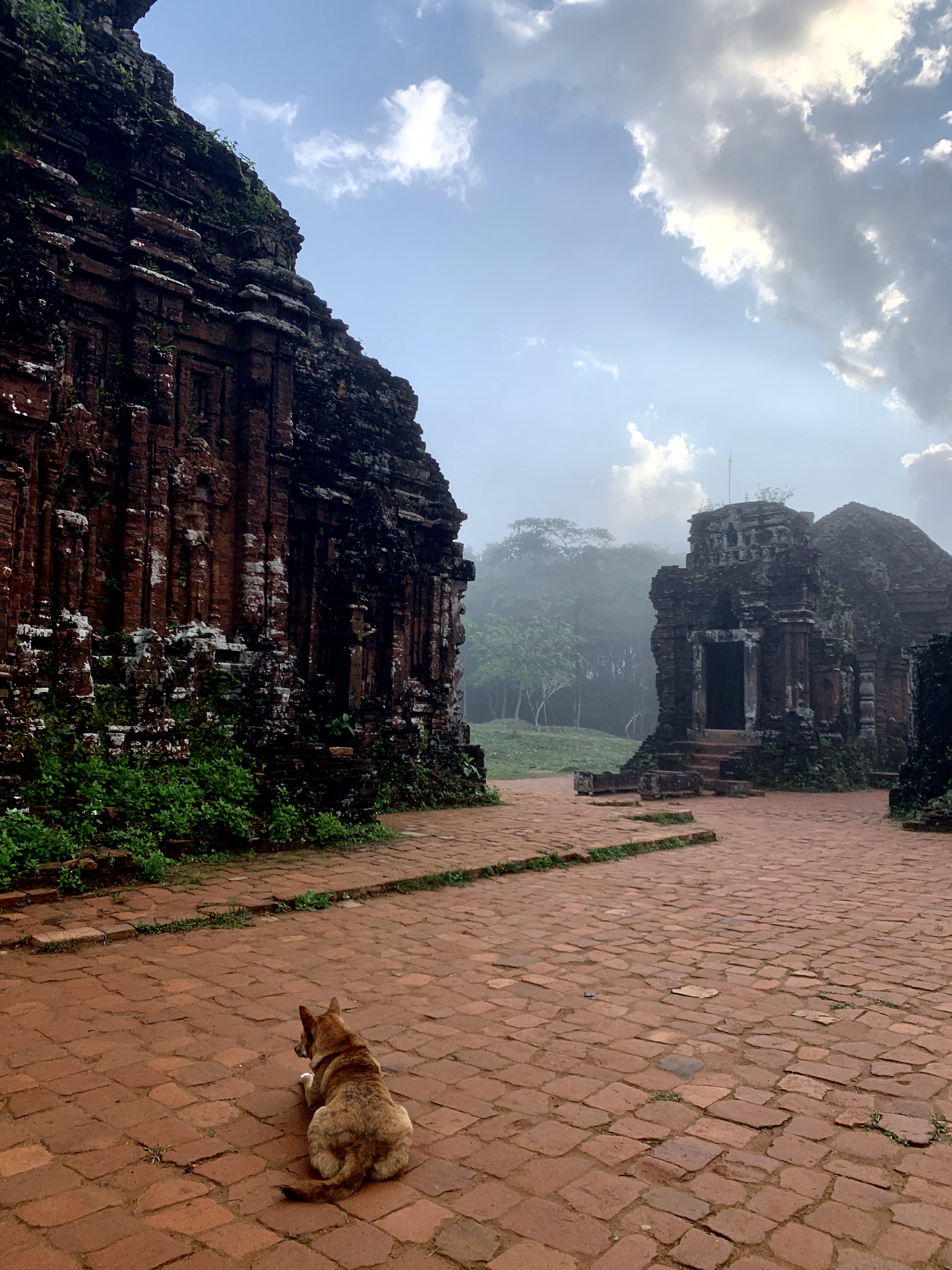
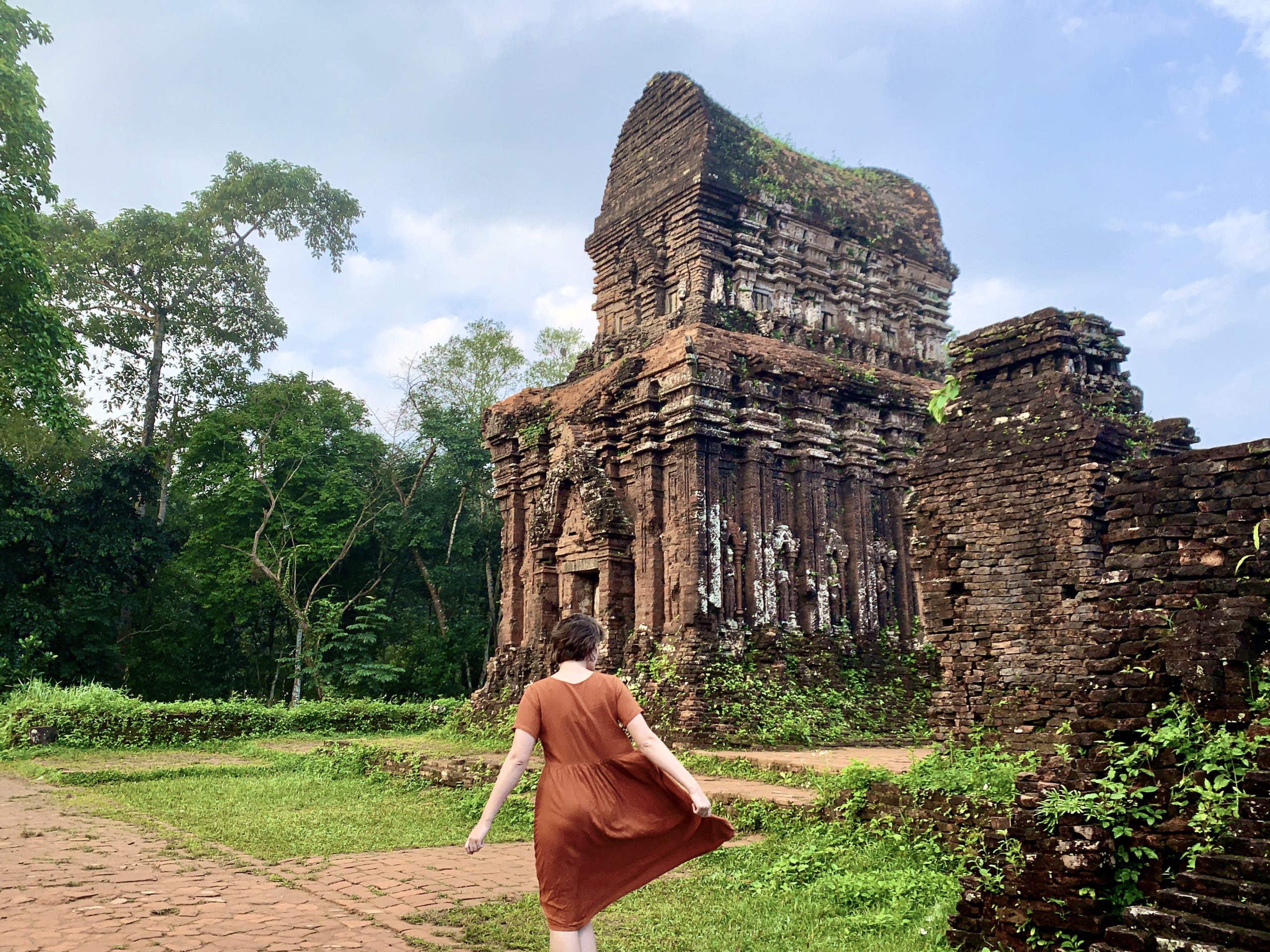
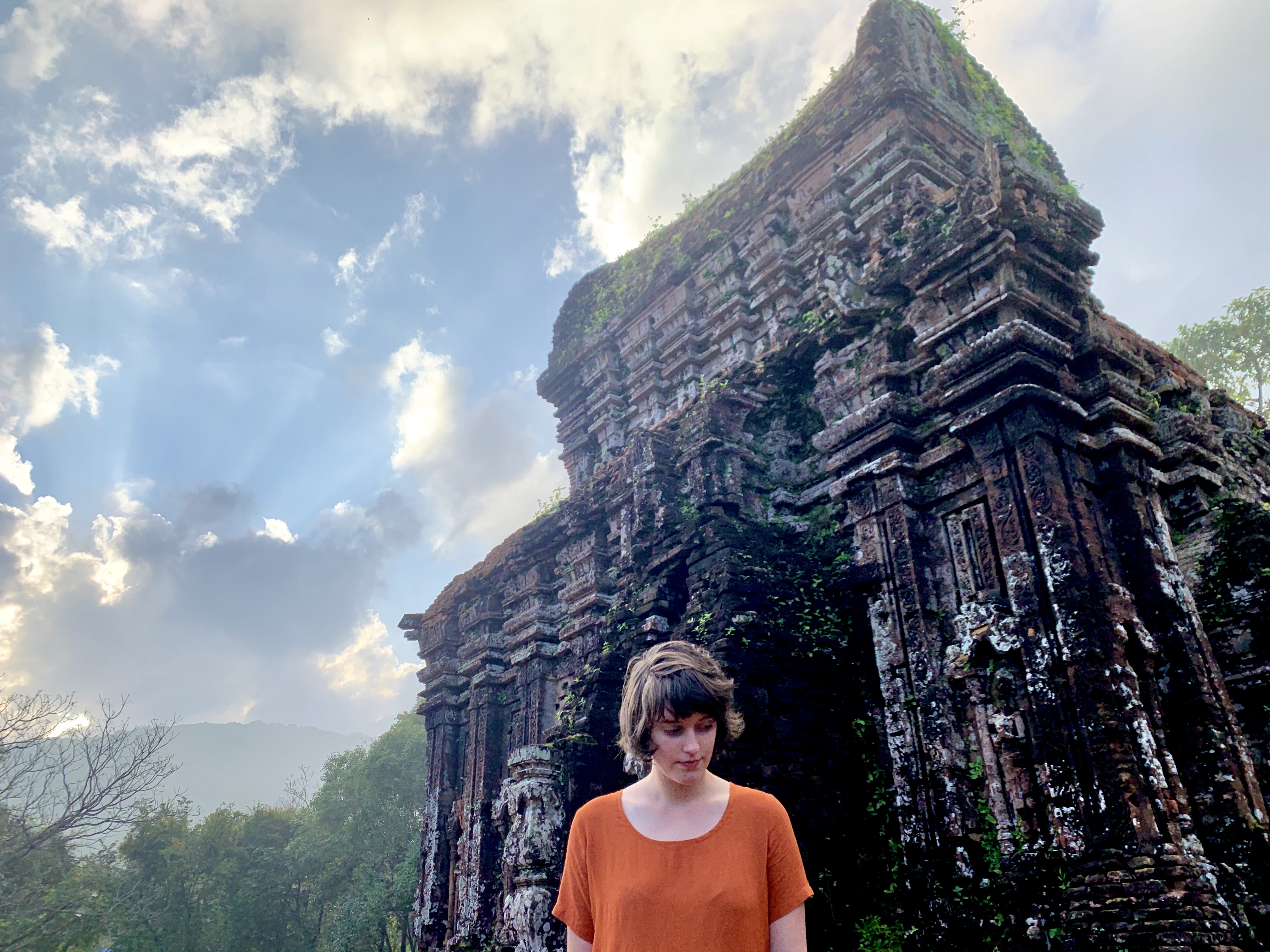
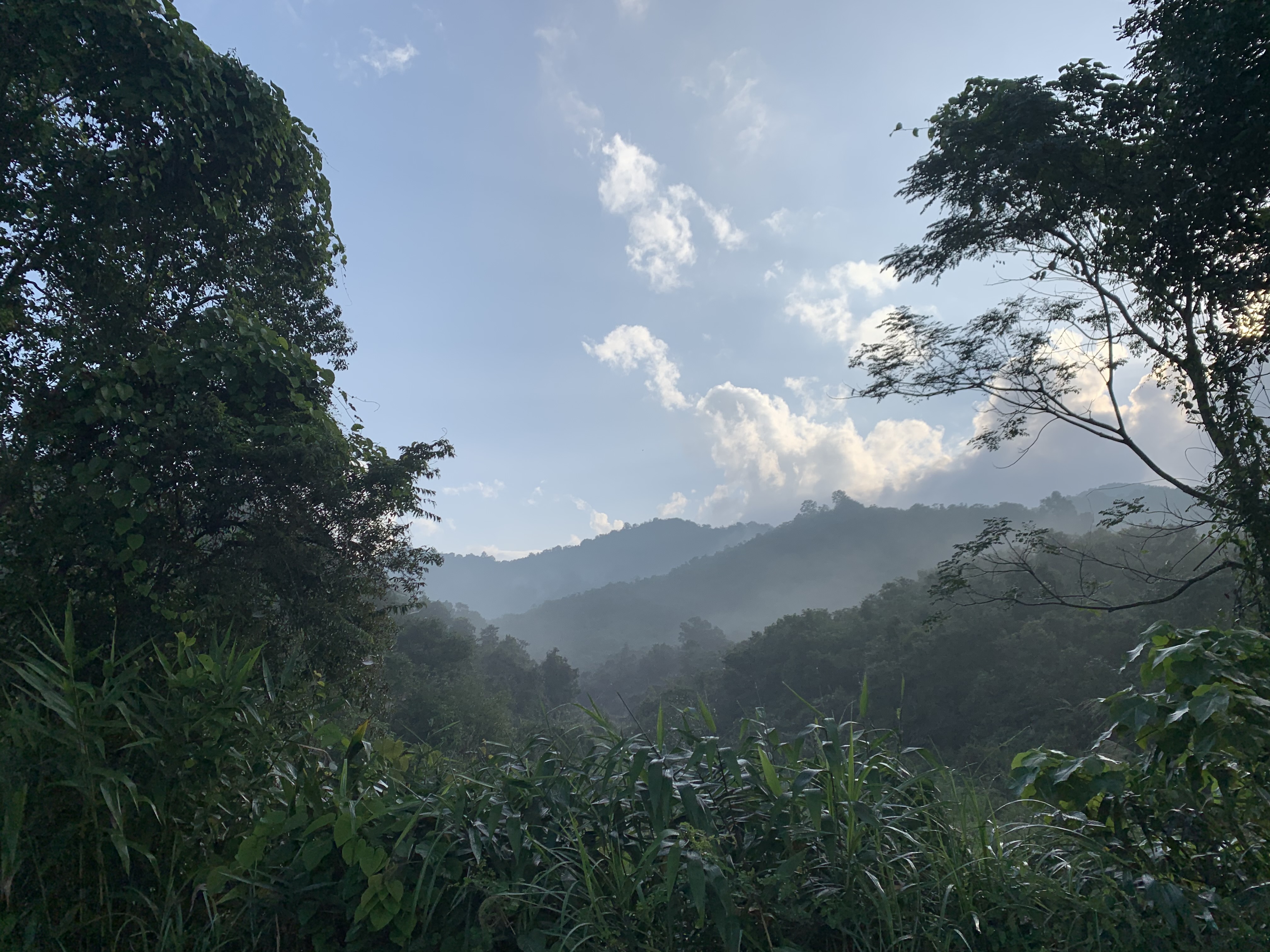
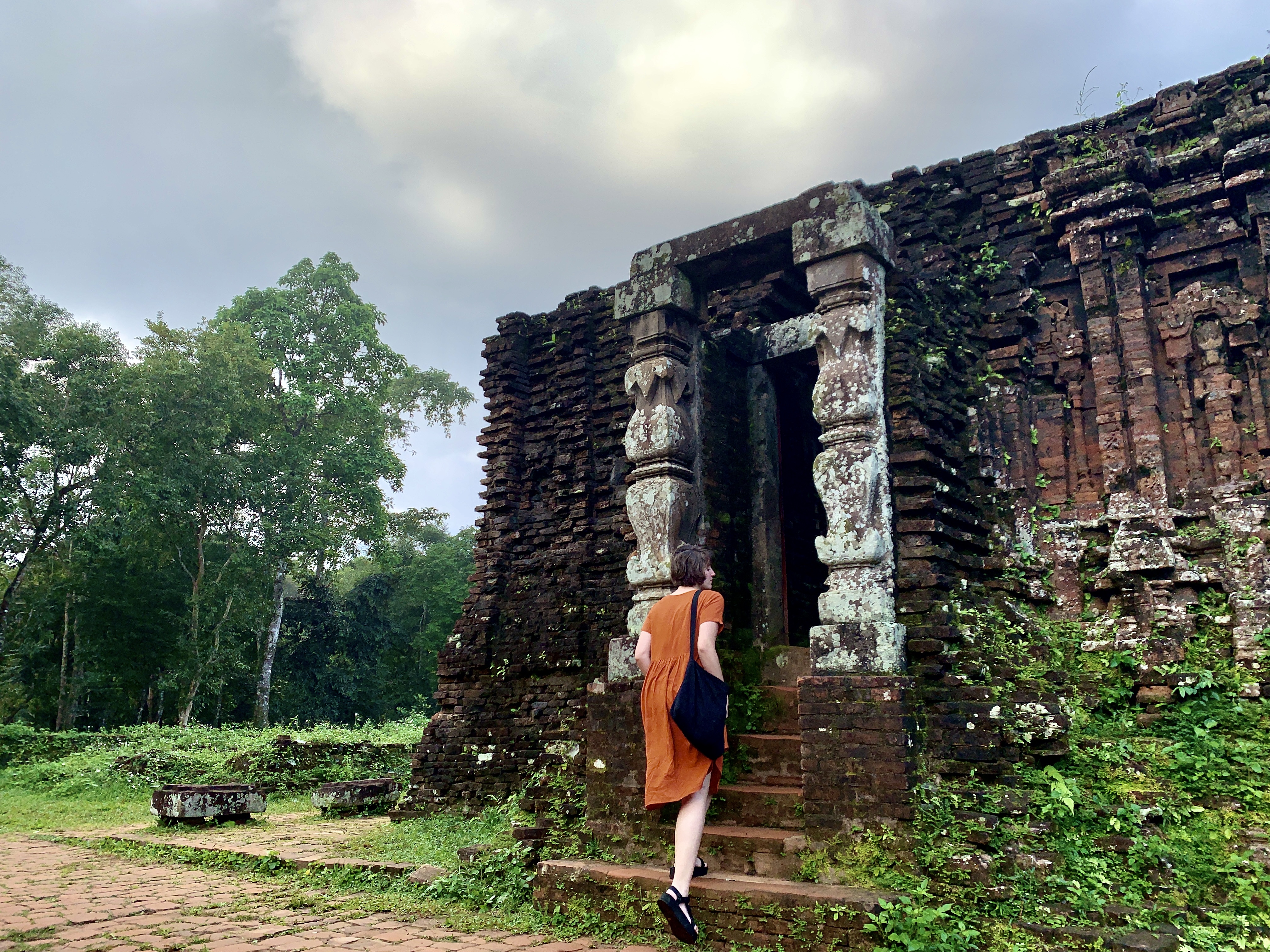
I was hooked on Hoi An from the moment I got there, drawn in by the vibrant colors, glistening water, mouthwatering food, and kind people. I left there content with the time I was able to spend in central Vietnam, and with three new pieces of clothing as a bonus! Hoi An is definitely not a destination to be left out of a Vietnam itinerary.
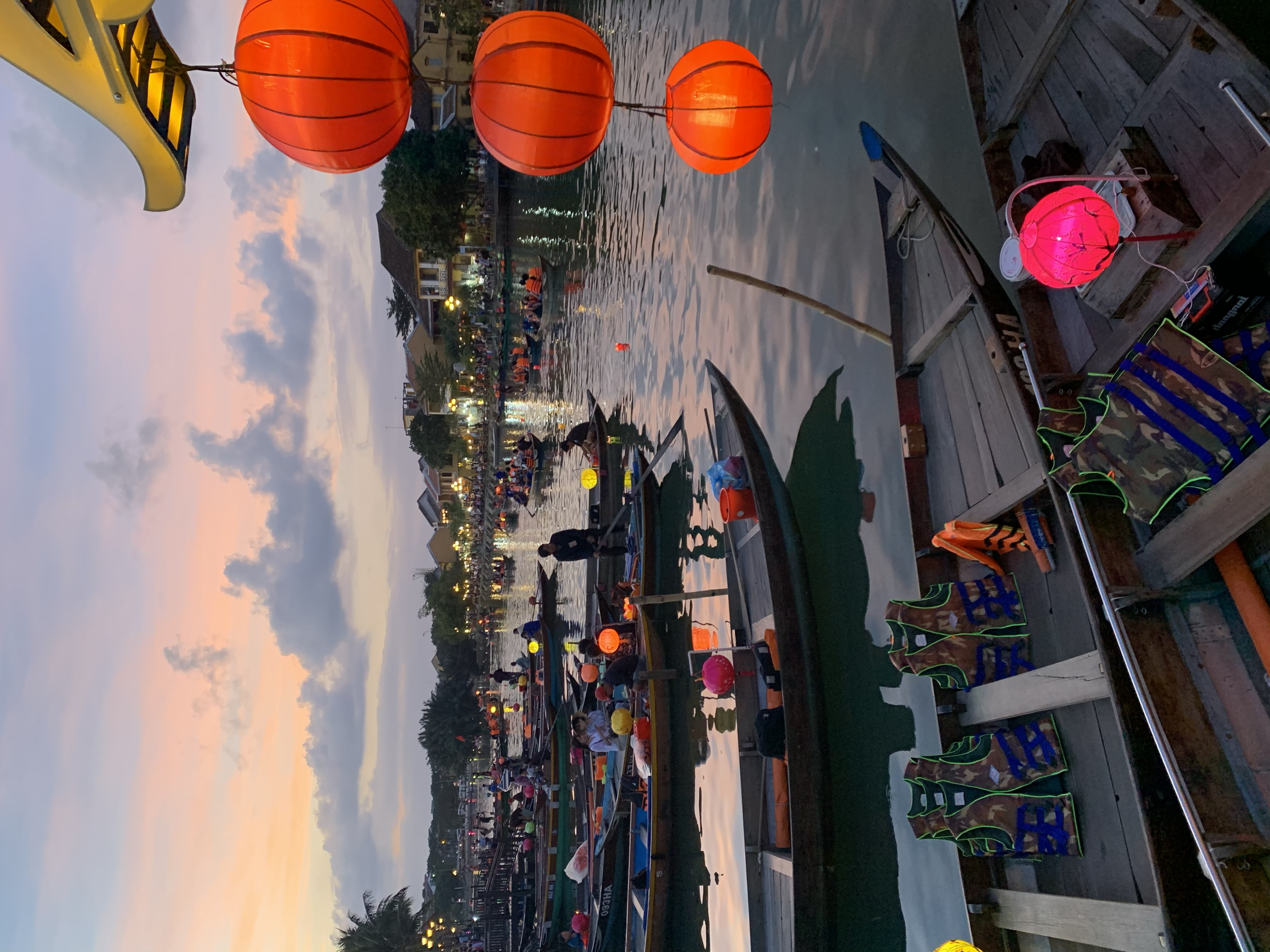
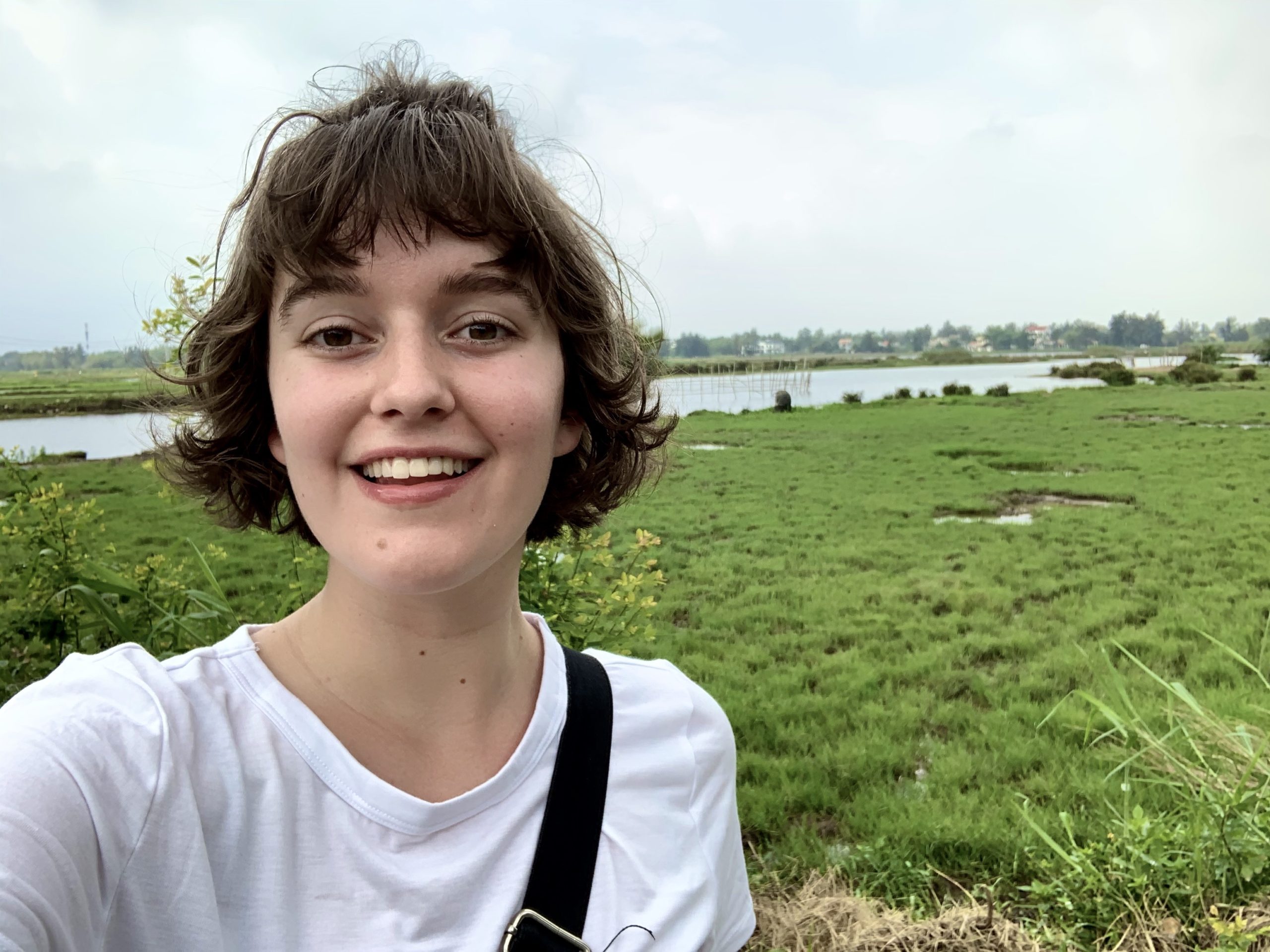
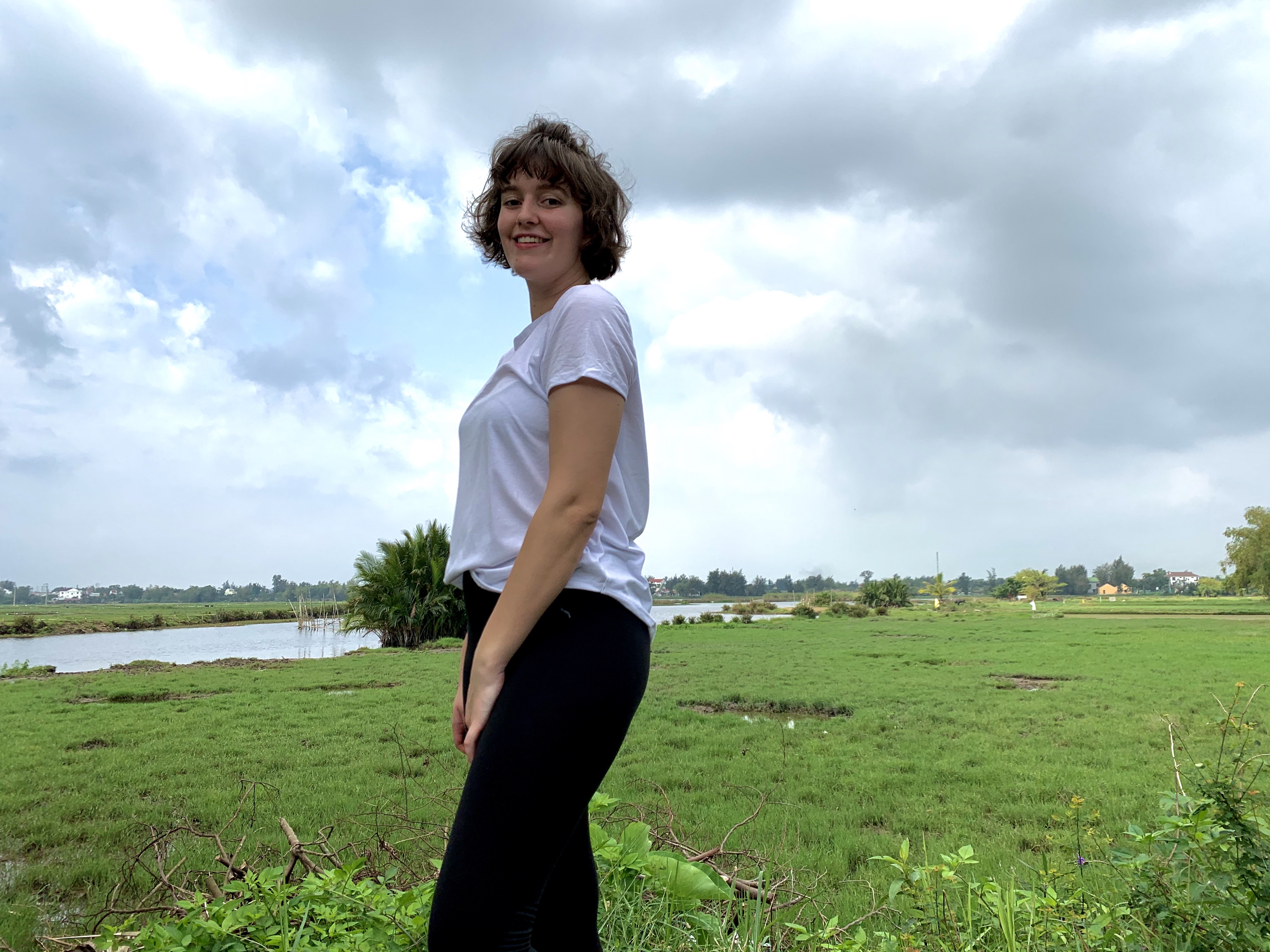
You definitely gave us the most interesting tour of Hoi An. I enjoy your blogs so very much. I feel like I’ve been there myself except for the added bonus of photos of you. Photos of the surrounding is a close second. Love you!! The outfits you had sewn for you are gorgeous.